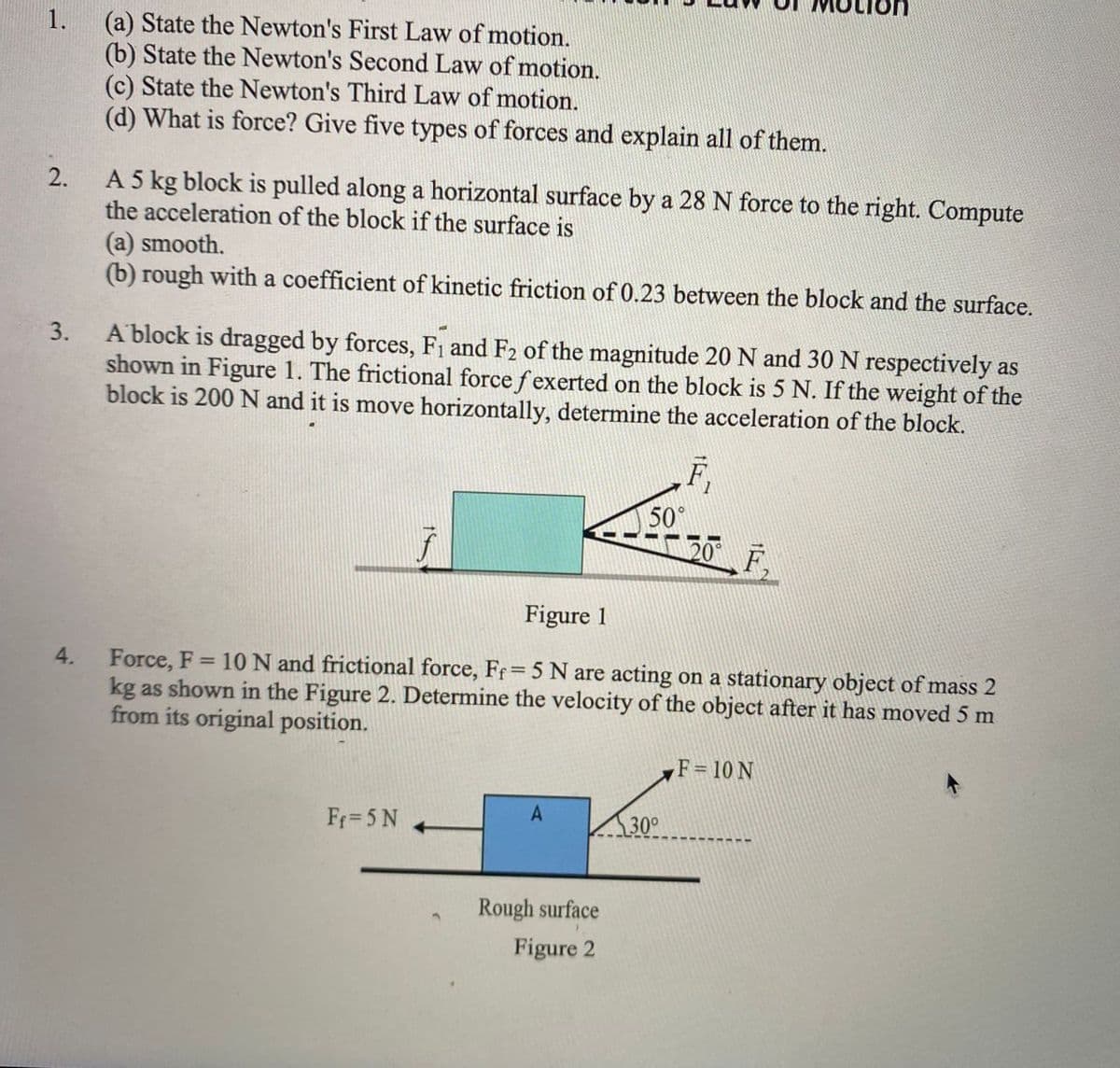(a) State the Newton's First Law of motion. (b) State the Newton's Second Law of motion. (c) State the Newton's Third Law of motion. (d) What is force? Give five types of forces and explain all of them.
(a) State the Newton's First Law of motion. (b) State the Newton's Second Law of motion. (c) State the Newton's Third Law of motion. (d) What is force? Give five types of forces and explain all of them.
Physics for Scientists and Engineers: Foundations and Connections
1st Edition
ISBN:9781133939146
Author:Katz, Debora M.
Publisher:Katz, Debora M.
Chapter6: Applications Of Newton’s Laws Of Motion
Section6.4: Kinetic And Rolling Friction
Problem 6.7CE: What forces act on you as you walk across a room? Draw a free-body diagram showing all of them....
Related questions
Topic Video
Question

Transcribed Image Text:1.
(a) State the Newton's First Law of motion.
(b) State the Newton's Second Law of motion.
(c) State the Newton's Third Law of motion.
(d) What is force? Give five types of forces and explain all of them.
A 5 kg block is pulled along a horizontal surface by a 28 N force to the right. Compute
the acceleration of the block if the surface is
2.
(a) smooth.
(b) rough with a coefficient of kinetic friction of 0.23 between the block and the surface.
A block is dragged by forces, Fi and F2 of the magnitude 20 N and 30 N respectively as
shown in Figure 1. The frictional force fexerted on the block is 5 N. If the weight of the
block is 200 N and it is move horizontally, determine the acceleration of the block.
3.
F,
50°
20 F,
Figure 1
Force, F = 10 N and frictional force, Fr= 5 N are acting on a stationary object of mass 2
kg as shown in the Figure 2. Determine the velocity of the object after it has moved 5 m
from its original position.
4.
F= 10 N
A
Ff= 5 N
30°
Rough surface
Figure 2
![Two blocks, A of mass 10 kg and B of mass 30 kg, are side by side and in contact with
each another. They are pushed along a smooth floor under the action of a constant force
F of magnitude 200 N applied to A as shown in Figure 3. Determine
a) the acceleration of the blocks,
b) the force exerted by A on B.
5.
F-
A
Figure 3
Two weights 40 N and 70 N are hung at the ends of a light inelastic string over a light
and frictionless pulley. Compute the acceleration of the weights and the tension in the
string.
[Take g = 10 ms²]
6.
(a) A block of mass 6 kg on a smooth table is connected with a string to another block of
mass 3 kg through a smooth pulley as shown in Figure 4. Calculate the acceleration of
the system and the tension of the string.
(b) If the table is replaced with another one which has a rough surface of coefficient of
friction uk = 0.22. Calculate the acceleration and the tension of the string.
7.
%3D
6 kg
3kg
Figure 4
A 4 kg box is pulled along a horizontal surface (uk 0.23) by a light and inelastic rope
over a light and frictionless pulley by a 3 kg hanging mass.
(a) Find the acceleration of the box and the tension in the rope.
(b) Compute the acceleration of the box and the tension in the rope if the 3 kg mass is
placed on a smooth inclined plane with an angle of inclination of 57°.
8.
%3D](/v2/_next/image?url=https%3A%2F%2Fcontent.bartleby.com%2Fqna-images%2Fquestion%2Fb3fca115-c61a-416a-8874-7bc5fe306140%2F0bf68a09-fce4-4d1d-9ef1-a0dfbb567647%2Fwj4ytly_processed.jpeg&w=3840&q=75)
Transcribed Image Text:Two blocks, A of mass 10 kg and B of mass 30 kg, are side by side and in contact with
each another. They are pushed along a smooth floor under the action of a constant force
F of magnitude 200 N applied to A as shown in Figure 3. Determine
a) the acceleration of the blocks,
b) the force exerted by A on B.
5.
F-
A
Figure 3
Two weights 40 N and 70 N are hung at the ends of a light inelastic string over a light
and frictionless pulley. Compute the acceleration of the weights and the tension in the
string.
[Take g = 10 ms²]
6.
(a) A block of mass 6 kg on a smooth table is connected with a string to another block of
mass 3 kg through a smooth pulley as shown in Figure 4. Calculate the acceleration of
the system and the tension of the string.
(b) If the table is replaced with another one which has a rough surface of coefficient of
friction uk = 0.22. Calculate the acceleration and the tension of the string.
7.
%3D
6 kg
3kg
Figure 4
A 4 kg box is pulled along a horizontal surface (uk 0.23) by a light and inelastic rope
over a light and frictionless pulley by a 3 kg hanging mass.
(a) Find the acceleration of the box and the tension in the rope.
(b) Compute the acceleration of the box and the tension in the rope if the 3 kg mass is
placed on a smooth inclined plane with an angle of inclination of 57°.
8.
%3D
Expert Solution
This question has been solved!
Explore an expertly crafted, step-by-step solution for a thorough understanding of key concepts.
This is a popular solution!
Trending now
This is a popular solution!
Step by step
Solved in 5 steps

Knowledge Booster
Learn more about
Need a deep-dive on the concept behind this application? Look no further. Learn more about this topic, physics and related others by exploring similar questions and additional content below.Recommended textbooks for you

Physics for Scientists and Engineers: Foundations…
Physics
ISBN:
9781133939146
Author:
Katz, Debora M.
Publisher:
Cengage Learning

Physics for Scientists and Engineers: Foundations…
Physics
ISBN:
9781133939146
Author:
Katz, Debora M.
Publisher:
Cengage Learning